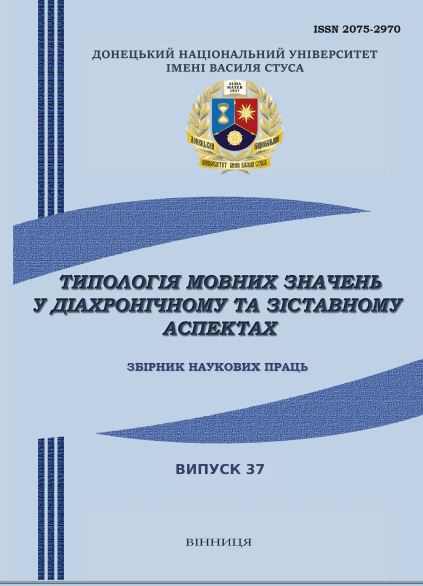An Outline of the Sir Orfeo.
DOI:
https://doi.org/10.31558/2075-2970.2019.37.6Keywords:
Orfeo, Sir Orfeo, Greek mythology, Irish mythology, Welsh mythology, Celtic folklore, Celtic OtherworldAbstract
The main purpose of this article is to introduce the modern reader into the medieval English poem Sir Orfeo as to its origins, authorship, extant manuscripts, argument, characters, its relationship with the classical Greek myth of Orpheus and its relationship with the Celtic folklore in reference to the Otherworld. The approach of the article is eminently exploratory, descriptive, and informative, and is spurred, therefore, by the need to contextualize the medieval English poem from the historical and literary viewpoint before the reader carries out its preliminary reading. The introduction, therefore, will offer a general internal and external outlook of the English poem, and will briefly compare the interpersonal relationship between Orpheus and Eurydice as characters and the intrapersonal relationship between Orpheus and Eurydice with the Greek Underworld with this same interaction established between Orpheus and Heurodis as characters and Orpheus and Heurodis with the Celtic-style Otherworld of the English poem. The article includes, in addition, a fragment of the original poem in Middle English and its translation into modern Spanish which may provide readers with an idea of the classical Breton lay structure in Middle English, based upon Marie de France’s lays, an author who contributed decisively to fostering this kind of poems in Henry II’s England, and encourage other authors to continue in this line. Such lays could combine courtly love with the Supernatural World through appealing characters, such as knights, noble ladies, supernatural beings and, in some cases, mythological creatures.References
Allen, D., "Orpheus and Orfeo: The Dead and the Taken." Medium Aevum, 33 (1964), 102-11.
Alonso Navarro, José Antonio. Tres joyas de la literatura medieval inglesa: Incluye “El caballero Cleges” (Sir Cleges) además de El caballero Owain (Sir Owain) y La flor y la hoja. Asunción: Editorial Marben, 2014.
Alonso Navarro, José Antonio. Traducción del poema medieval inglés “El caballero Owain” (“Sir Owain”). (Traducción revisada y crítica) Revista Linguae: Sociedad Española de Lenguas Modernas (SELM). No. 01. 2014. ISSN: 2386-8414.
Alonso Navarro, José Antonio. Traducción del poema medieval inglés “El caballero Degaré” (Sir Degaré). Asunción: Editorial Marben, 2015.
Alonso Navarro, José Antonio. Traducción del poema medieval inglés “El caballero Corneus” (Sir Corneus). Revista Linguae: Sociedad Española de Lenguas Modernas (SELM). No. 02. 2015. ISSN: 2386-8414.
Alonso Navarro, José Antonio. Traducción del poema medieval inglés o lay bretón “El caballero Launfal” (Sir Launfal). Revista Linguae: Sociedad Española de Lenguas Modernas (SELM). N° 03. 2016. ISSN: 2386-8414.
Alonso Navarro, José Antonio. Traducción del poema medieval inglés “El caballero Isumbras” (Sir Isumbras) (Un romance / lay bretón medieval inglés en “Middle English”). UniNorte (Universidad del Norte): Asunción, Paraguay. 2016. Presentado por el Embajador del Reino Unido acreditado en Paraguay, doctor Jeremy Hobbs, PhD y el historiador y literato francés, doctor Alain Saint-Säens, PhD.
Alonso Navarro, José Antonio. Traducción del poema medieval inglés “La isla de las mujeres” (The Isle of Ladies) (Un poema medieval inglés en “Middle English”). UniNorte (Universidad del Norte): Asunción, Paraguay. 2017. Presentado por el Encargado de Negocios de la Embajador del Reino Unido en Asunción, Señor Nick White en representación del Excelentísimo Embajador del Reino Unido acreditado en Paraguay, doctor Jeremy Hobbs, PhD., y el historiador y literato francés, doctor Alain Saint-Säens, PhD.
Alonso Navarro, José Antonio. Traducción del poema medieval inglés “El caballero Eglamour de Artois” (Sir Eglamour of Artois) (Un poema medieval inglés en “Middle English”). UniNorte (Universidad del Norte): Asunción, Paraguay. 2018.
Alonso Navarro, José Antonio. Dos divertidos cuentos medievales ingleses: traducción del poema medieval inglés El cuento del bacín (The Tale of the Basin) y de La dama priora (The Lady Prioress). Prólogo del doctor Miguel Ayerbe (Universidad del País Vasco en Vitoria, España) y notas de la doctora Melissa M. Furrow (Dalhousie University, Nova Scotia, Canada). Asunción: Universidad del Norte (UniNorte), 2018.
Bliss, A. J., ed. Sir Orfeo. 2nd ed. Oxford: Clarendon Press, 1966.
Laskaya, Anne & Salisbury, Eve. (Ed.). The Middle English Breton Lays. Michigan: Medieval Institute Publications, 1995.
Lerer, Seth. "Artifice and Artistry in Sir Orfeo." Speculum 60 (1985), 92-109.
Liuzza, Roy Michael. "Sir Orfeo: Sources, Traditions, and the Poetics of Performance." Journal of Medieval and Renaissance Studies 21 (1991), 269-84.
Magnúsdóttir, Ásdís R. La Voix du cor. Amsterdam: Rodopi, 1998.
Rumble, Thomas, ed. The Breton Lays in Middle English. Detroit, MI: Wayne State University Press, 1965.
Shuffelton, George. (Ed). Codex Ashmole 61: A Compilation of Popular Middle English Verse. Michigan: Medieval Institute Publications, 2008.
Zipes, Jack. The Oxford Companion to Fairytales. Oxford: Oxford University Press, 2009.

